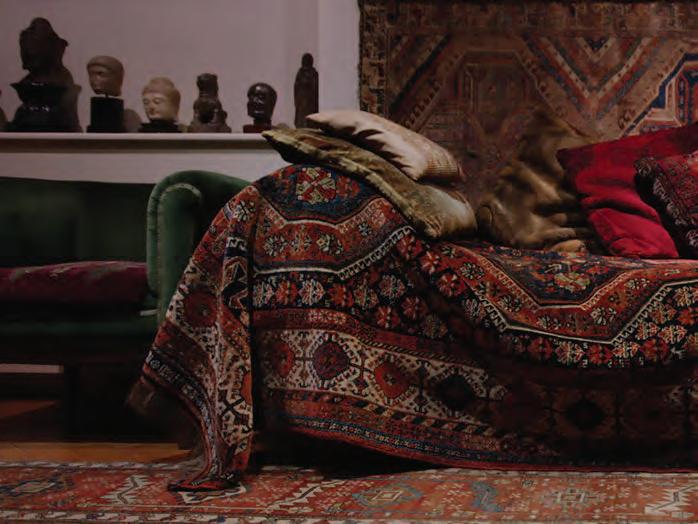
4 minute read
Amie Siegel
Amie Siegel
Fetish [Fetiche], 2016
Advertisement
En Fetish, Amie Siegel nos invita a reflexionar sobre los procesos de fetichización con los que nos vinculamos a determinados objetos. El término fetiche aglutina varios significados. En su origen feitiço era la palabra con la que los portugueses denominaban algunos objetos novedosos que se encontraban en el África Occidental en el siglo XVI, cuyo valor les era desconocido. El término no aludía a elementos pertenecientes a una cultura específica, sino que cumplía la función de traducir y transvalorar objetos en el contexto de un encuentro entre sistemas sociales y religiosos radicalmente heterogéneos. Estos objetos encarnaban valores religiosos, comerciales, estéticos y sexuales para los que no había términos de comparación desde Occidente. Esta dificultad para determinar el valor de las cosas es recogida por Karl Marx al identificar fetiche y mercancía, entendiendo ésta como un constructo social por el que se otorga un valor monetario en el que intervienen factores no descifrables. Posteriormente Sigmund Freud utiliza el término para designar un tipo de objeto donde se sitúan proyecciones y deseos sexuales, cuyas motivaciones tampoco son legibles. También se llaman fetiches algunos amuletos que se llevan en el cuerpo a los que se les atribuye un poder mágico y es así como Picasso
In Fetish, Amie Siegel invites us to reflect on the fetishizing mechanisms through which we imbue objects with personal meaning. The word “fetish” can mean several things. Originally, feitiço was a term that the Portuguese applied to novelties discovered in West Africa in the 16th century whose value was a mystery to them. It did not refer to objects pertaining to any particular culture, but merely served to translate and trans assess objects at the intersection of radically different social and religious systems. These objects had religious, commercial, aesthetic and sexual meanings for which there were no comparable terms in the West. The difficulty of determining the value of things was expressed by Karl Marx when he coined the term “commodity fetishism”, a social construct for assigning monetary value based on indecipherable factors. Sigmund Freud later applied the word fetish to an object that encapsulates sexual desires and projections whose underlying motivations are equally unreadable. Amulets worn on the body and believed to have magical powers are also called fetishes, and Picasso used the same word to describe the “Art Négre” sculptures he discovered at the Trocadéro.
Equating artworks with fetishes, Siegel’s creations frequently explore
denominó las esculturas de “arte negro” que se encontró en el Museo del Trocadéro.
Equiparando las obras de arte con los fetiches, los trabajos de Siegel frecuentemente se preguntan por el modo el que se dota de significado y valor a determinados objetos artísticos, basándose en una serie de creencias indeterminadas. En Fetish, Siegel encuentra en la colección de estatuillas arqueológicas y artefactos que Freud tenía en su estudio un ejemplo doble de esta asignación. Como psicoanalista, la dificultad de desentrañar el misterio por el que los objetos se convierten en portadores de creencias, significados ocultos y proyecciones personales y colectivas, resuena en su práctica investigadora e interpretadora. Como coleccionista, él mismo es objeto de esta fascinación, que le lleva a identificarse con los arqueólogos. La conversión de su estudio en un museo preserva los deseos y valores con los que Freud imbuía a sus objetos y los convierte en fetiches. La musealización transforma el valor personal otorgado a las cosas materiales en objetos sociales. Mediante el registro de la limpieza anual de los mismos, Siegel nos permite la observación de cerca de algunos de los gestos rituales con los que se afirma este proceso. Los museos se revelan así como espacios transculturales donde producir, traducir y resignificar nuevos fetiches cuya naturaleza heterogénea siempre dejan ocultos deseos individuales y colectivos.
how certain artistic objects are imbued with meaning and value based on a set of indeterminate beliefs. In Fetish, Siegel finds a dual example of this attribution in the collection of archaeological figurines and artefacts kept in Freud’s study. As a psychoanalyst, the challenge of unravelling the mystery of how objects become vessels of beliefs, hidden meanings and personal and collective projections permeated Freud’s research and interpretations. As a collector, he himself was an object of that fascination, leading him to identify with archaeologists. The transformation of his study into a museum preserves the desires and values which Freud attributed to his objects, turning them into fetishes. Musealization transforms the personal value assigned to material things and makes them social objects. By portraying the annual cleaning of those objects, Siegel allows us to closely observe some of the ritual gestures that reaffirm this process. Museums are thus revealed as crosscultural spaces for producing, translating and re-signifying new fetishes whose heterogeneous nature always conceals individual and collective desires.











